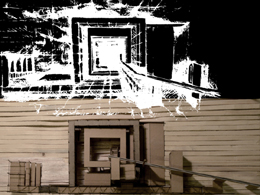STUDENTS PROJECTS
PROJECTS2013
Students : Koumoutsos Stavros, Marios Salatas
Surpervisor: Sofia Tsiraki (assistant professor NTUA Architecture)
Consultants: Io Carydi (NTUA Architecture), Panayotis Touliatos (NTUA Architecture), Grigoris Iatrou (Biology, University of Patras), Iordanis Chantzipavlidis (Agricultural University of Athens)
National Technical University of Athens, school of Architecture Engineering
Presentantion date : Summer 2013

The relation between agricultural activity and specialised tourism arose as a thematic of the project through an analytic research of the greater region of the National Park of Chelmos-Vouraikos - where the are belongs to - and the very characteristics of Doksa Lake. The premises, on the one hand, facilitate research and pedagogical activities of the Park Operator, and on the other, they address extensive farming activity of Feneos as a composting plant for organic fertilizer.

The buildings dialectics with the locus opens up its role as a utilitarian object, a machine building, as the residents relate to it through their labour.
Its double role converts the building into a centre of topical and hypertopical importance, that addresses both specialised tourism and nearby residents. Bean farmers bring here their annual agriwaste, which is composted into organic fertilizer for them to use in the next crops.

The lake and its hydrocritical system are involved in the architectural vocabulary of the design. A downstream in the landscape and the functional structure of the lake as a natural cavity that collects water drainage and ooze, these are two of the elements that are spatially transcribed in the design.

Via free representations, but also a more Cartesian illustration of the hydrocritical system of the lake, the natural cavity that collects matter around a conceivable centre is part of the main idea.

The uncovered loadbearing system is distict in the design, which constructs the very spaces, while the filling elements consist of glass and panels, where necessary (eg. hygiene facilities), and wooden planks. The structural system comprises of mixed constructions of reinforced concrete and timber frame in a cage system.

A robust, chthonic, concrete base settles on the ground, which accommodates the production line and research laboratories. In its internal crescendo, the base expands vertically into a ring for the library.

On top of the concrete base, a light, kinetic construction by timber frame is arranged to function as environmental exhibition spaces and the public linear downstream concluding at an outdoor rest area. In its vertical expansion, it forms a "tower", where is the main entrance for the premises and its vertical access to different levels.

The design forms a sequence of flows, which are arranged in a spiral expansion around the open atrium.
Spaces are organized in a constant interchange between interior and exterior, as the visitor proceeds from exhibition spaces to those of the production. Human flows are intertwined along a spiral expansion which channels them to the botanical gardens and the lake. The visitor descends to the ground level, and exits through a construction of gabions, in which the sacks of fertilizer are piled. In this way of filtering the movement flows, a pedagogical route is completed which begins and ends in the natural landscape.

The building's typology draws from monasterial models which foucauldian genealogy teaches how the laboratory exemplar originates from.
In the traditionally picturesque "Arcadic Nature", the surrounding landscape is programmatically involved in the building's context. Natural terrain penetrates the building on ground level as a botanical garden comprising the third part of the exhibition (after the environmental exhibition and the composting process).












